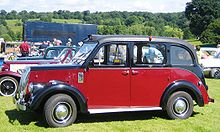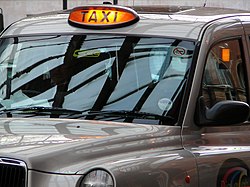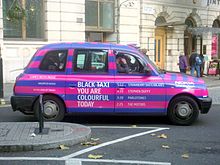Hackney carriage
This template is a customized wrapper for {{[[Template:{{{1}}}|{{{1}}}]]}}. Any field from {{[[Template:{{{1}}}|{{{1}}}]]}} can work so long as it is added to this template first. Questions? Just ask here or over at [[Template talk:{{{1}}}]]. |
|

|-
|

|-
|

|} A hackney or hackney carriage (also called a cab, hack or London taxi) is a carriage or automobile for hire.[1] A livery carriage superior to the hackney was called a remise.[2]
In the United Kingdom, the name hackney carriage refers to a taxicab licensed by the Public Carriage Office in Greater London or by the local authority (non-metropolitan district councils or unitary authorities) in other parts of Great Britain, or by the Department of the Environment in Northern Ireland.
In the United States, the police department of the city of Boston, has a Hackney Carriage Unit, analogous to taxicab regulators in other cities, that issues Hackney Carriage medallions to its taxi operators.[3]
Etymology
The name 'hackney' was once thought to be an anglicized derivative of French haquenée—a horse of medium size recommended for lady riders; however, current opinion is that it is derived from the village name Hackney (now part of London).[4] The first documented 'hackney coach'—the forerunner of the more generic 'hackney carriage'—operated in London in 1621.
The New York colloquial terms "hack" (taxi or taxi-driver), "hackstand" (taxi stand), and "hack license" (taxi license) are probably derived from "hackney carriage", but such cabs are now regulated by the New York City Taxi and Limousine Commission.
History
"An Ordinance for the Regulation of Hackney-Coachmen in London and the places adjacent" was approved by Parliament in 1654, to remedy what it described as the "many Inconveniences [that] do daily arise by reason of the late increase and great irregularity of Hackney Coaches and Hackney Coachmen in London, Westminster and the places thereabouts".[5] The first hackney-carriage licences date from 1662, and applied literally to horse-drawn carriages, later modernised as hansom cabs (1834), that operated as vehicles for hire. There was a distinction between a general hackney carriage and a hackney coach, a hireable vehicle with specifically four wheels, two horses and six seats, and driven by a Jarvey (also spelled jarvie).
Electric hackney carriages appeared before the introduction of the internal combustion engine to vehicles for hire in 1901. During the 20th century, cars generally replaced horse-drawn models, and the last horse-drawn hackney carriage ceased service in London in 1947. A small, usually two-wheeled, one-horse hackney vehicle called a noddy once plied the roads in Ireland and Scotland. The French had a small hackney coach called a fiacre.
UK regulations define a hackney carriage as a taxicab allowed to ply the streets looking for passengers to pick up, as opposed to private hire vehicles (sometimes called minicabs), which may pick up only passengers who have previously booked or who visit the taxi operator's office.
Horse-drawn cabs today
Horse-drawn hackney services continue to operate in some other parts of the UK, for example in Cockington, Torquay. The Australian city of Melbourne has, in recent years, introduced horse-drawn hire carriages as an adjunct to its promotion of tourism .
Black cabs


Motorised hackney cabs in the UK, traditionally all black in London and most major cities, are traditionally known as black cabs (which they were), although they are now produced in a variety of colours, sometimes in advertising brand liveries (see below). The 50 golden cabs produced for the Queen's Golden Jubilee celebrations in 2002 were notable.[6]
Vehicle design
Historically four-door saloon cars have been highly popular as hackney carriages, but with disability regulations growing in strength and some councils offering free licensing for disabled-friendly vehicles, many operators are now opting for wheelchair-adapted taxis such as the Peugeot E7 and the many similar models. Other models of specialist taxis include LTI, Fiat, Volkswagen, Metrocab and Mercedes-Benz. These vehicles normally allow six or seven passengers, although some models can accommodate eight. Some of these 'minibus' taxis include a front passenger seat next to the driver, while others reserve this space solely for luggage.
Many black cabs have a turning circle of only 25 ft (8 m). One reason for this is the configuration of the famed Savoy Hotel: The hotel entrance's small roundabout meant that vehicles needed the small turning circle in order to navigate it. That requirement became the legally required turning circles for all London cabs, while the custom of a passenger's sitting on the right, behind the driver, provided a reason for the right-hand traffic in Savoy Court, allowing hotel patrons to board and alight from the driver's side.[7]
Driver qualification
In London, hackney-carriage drivers have to pass a test called The Knowledge to demonstrate they have an intimate knowledge of London streets. There are currently around 21,000 black cabs in London, licensed by the Public Carriage Office.[8]
Elsewhere, councils have their own regulations. Some merely require a driver to pass a Criminal Records Bureau disclosure and have a reasonably clean driving licence, while others use their own localised versions of London's The Knowledge test.
Private users
Oil millionaire Nubar Gulbenkian drove about in a custom-built gold and black car, designed to look like a vintage London taxi and powered by a Rolls-Royce engine, because he had been told "it can turn on a sixpence — whatever that is."[9][10] Other celebrities are known to use hackney carriages both for their anonymity and their ruggedness/manoeuvrability in London traffic. Users include Prince Philip, whose cab has been converted to run on liquefied petroleum gas, according to the British royal website,[11] and author Stephen Fry.[12] Black cabs also have recently served as recording studios for indie band performances and other performances in the Black Cab Sessions internet project.
British TV Presenter, Yvette Fielding owns one and it is seen on her show Ghosthunting With....
Before the Falklands war, governor Rex Hunt of the Falkland Islands used a former London black cab as his official vehicle.[13] The cab (with special registration number FI MNT, standing for Falkland Islands Museum and National Trust) was still in use as the Governor's official car for parades in the Falkland Islands until 2009. The future of the cab is uncertain because, although the Governor could (while wearing the ostrich feather hat and sword that form part of his civil uniform) get in and out of the cab with more diginity than the car currently being used, the cab requires increasing maintenance with its age.
In other countries

Between 2003 and August 1st 2009 it was possible to purchase the London taxi model TXII in the United States. Today there are approximately 250 TXIIs in the US, operating as taxis in San Francisco, Dallas, Long Beach, Houston, New Orleans, Las Vegas, Newport, Rhode Island and Portland, Oregon. The largest operating fleet in North America is located in Charleston, South Carolina and owned by the Charleston Black Cab Company. They can also be seen in South Africa and Cyprus, as well as in Israel, where a Chinese-made version of LTI's model TX4 built by Geely Automobile is available for sale. On February 2010, a number of TX4s started operating in the capital of Kosovo - Pristina. They are known as London Taxi.[14] From July 2009 London taxis will not be available to buy new in the United States.[15] Singapore has also used London-style cabs since 2000; they charge higher rates than most other models.
Variety of models
There have been different makes and types of hackney cab through the years,[16] including:
- Beardmore Marks I to VII
- Austin FX3
- Austin/Carbodies/LTI FX4 and Fairway
- MCW/Reliant/Hooper Metrocab
- LTI TX1, TXII and TX4
- Mercedes-Benz Vito
- Peugeot E7
- Ford Journey
- Volkswagen Odyssey
Use in advertising

The London taxi has caught the eye of many advertising agencies because the body style is unique. The vehicle has therefore often been wrapped with advertising and used for marketing events both in the UK and in the US, including the Marmite Taxi, used to collect officials visiting the Marmite factory near Burton-on-Trent.
The first person to advertise on a London taxi was David Locke, who came up with the idea to uniquely advertise his London pub The Samuel Pepys.
References
- ^ Definition of hackney by the Online Dictionary from Datasegment.com
- ^ Definition of remise by the Free Online Dictionary, Thesaurus and Encyclopedia
- ^ Boston Police Hackney Carriage Unit
- ^ The history of the word "Hackney"
- ^ An Ordinance for the Regulation of Hackney-Coachmen in London and the places adjacent, June 1654 British History Online
- ^ Golden times for black cabs BBC News 13 March 2002
- ^ Why does traffic entering and leaving the Savoy Hotel in London drive on the right?, The Guardian.
- ^ A brief history of the hackney carriage and Public Carriage Office
- ^ Last of the big spenders in Time magazine, 24 Jan 1972
- ^ Photo of Gulbenkian in special cab Photographer Bryan Wharton, 1964
- ^ Prince Philip's taxi
- ^ Fry S. from Stephen Fry in America 10 Oct 2008
- ^ Imperial War Museum: Rex Hunt, Governor of the Falkland Islands
- ^ Ben-Gedalyahu, Dubi (18 August 2009). "Eldan to sell Chinese "London taxi"". Globes. Tel Aviv. Retrieved 18 October 2009.
{{cite web}}: Check|author-link=value (help); External link in|author-link= - ^ http://www.london-fleet.com/
- ^ TAXICAB MAKE and MODEL HISTORY
See also
- Taxicabs of the United Kingdom
- Illegal taxicab operation#Terminology
- Manganese Bronze — the manufacturer of London black cabs.
- Worshipful Company of Hackney Carriage Drivers
- Carriage
- Wagon
External links
- Austin Memories
- cab direct
- Hackney Coach. Georgian Index.
- London hackney coach regulations, 1819. Genealogy UK Genealogy and Family History.
- Taxis and private hire | Transport for London. Public Carriage Office.
- My London taxi Restoring and using a Fairway Taxi as everyday transport
- Taxi Cab Digital Advertising
